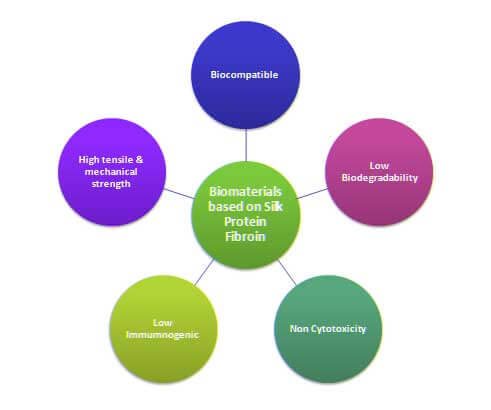The word ‘Silk’ makes us think first of glossy & shiny fabrics. The application of silk in medical field started in the nineteenth century when it replaced traditional metal wires as a suture material. Silkworms, with the help of epithelial cells in specialized glands, secrete 2 silk proteins – outer ‘sericin’ & inner core ‘fibroin’. Silk proteins have several important properties for serving as a good biomaterial including excellent mechanical strength, biocompatibility and controlled degradation in vivo [Figure 1]. These distinctive characteristics, along with its hydrophobic nature and ease of genetic manipulation, have led to use of silk as a biomaterial about three decades ago.
Human tissues or organs may suffer from damage due to trauma, various disorders or aging, which may lead to structural deformity or loss of function. Tissue engineering provides a ray of hope for management of such cases instead of traditional radical techniques like amputation or organ transplantation. In regenerative approach, scaffolds aid in formation of neotissue by providing the framework for the growth of support cells. Structure & mechanical characteristics of the tissue engineered construct depend on the nature of scaffold material. The disadvantages of synthetic polymers as scaffold material include low cytocompatibility and potential toxic degradation products. Silk has emerged as a promising biomaterial of natural origin for tissue engineering owing to its easy availability, low processing cost & long track record of application as a suture material.

The applications of silk biomaterials can be divided into three types (a) hard tissue engineering, (b) soft tissue engineering and (c) tissue engineering in the organ.
Hard tissues like bones and cartilage provide structural framework & support to the body. They constantly undergo growth, remodelling & repair. Replacement of lost bone or cartilage or repair of nonhealing defect is done by surgeons using autologous or exogenous bone or cartilage. Researchers have extensively studied application of silk or silk based composite scaffolds containing growth factors and precursor cells for regeneration of bone and cartilage.
Lost soft tissues such as ligaments, tendons, vessels, nerves, viscera, etc. due to injury or surgery are usually replaced in the body by a fibrous ‘scar’. Silk based tissue engineered cell–polymer constructs hold promise as scaffolds for tissue regeneration in such cases.
Regeneration of whole organ in the laboratory may be a possibility in near future using advanced techniques like lithography & inkjet printing of cells. Silk has been extensively applied for the treatment of skin wounds, liver tissue damage as well as in corneal and ear tissue engineering. In recent times, silk has been used in development of cardiac patches, breast reconstruction and treatment of bladder damage.
Thus the unique structure of silk, biocompatibility, versatility in processing, availability of different biomaterial morphologies, options for genetic engineering of variations of silks, ease of sterilization, thermal stability, surface chemistry for facile chemical modifications, and controllable degradation features makes silk a promising biomaterials for many clinical functions.